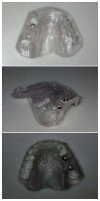Postextraction computer-guided implant surgery in partially edentate patients with metal restorations: a case report
- PMID: 28757938
- PMCID: PMC5516427
- DOI: 10.11138/orl/2017.10.1.071
Postextraction computer-guided implant surgery in partially edentate patients with metal restorations: a case report
Abstract
Objectives: The aim of the present study was to describe a postextraction, computer-guided protocol for implant-prosthetic rehabilitations in partially edentate patients with metal restorations.
Methods: A 60-year-old man with a loose FDP (fixed dental prosthesis) in the first quadrant was selected for a postextraction computer guided implantology according with the 2-piece radiographic template protocol. A two components radiographic template was produced, with the teeth setup portion based on the wax-up. CBCT (cone beam computed tomography) scans of the patient, wearing the base portion of the radiographic template and of the assembled radiographic template alone, were accomplished. The CBCT volume were imported in a dedicated software (NobelClinician, Nobel-Biocare, Kloten, Switzerland) and a surgical template was produced from the digital planning. The surgery was performed with a flap approach, as a bone regeneration procedure was carried out. A delayed loading protocol was chosen to allow a healing free of masticatory stress. A mobile partial denture was delivered to the patient to grant function and social life until the delivery of the definitive FDP.
Results: The surgery was performed rapidly and free of obstacles. A good primary stability of the implants was achieved. The patient referred an acceptable postoperative pain and swelling.
Conclusions: The 2-piece radiographic template protocol was evaluated as smooth, complication-free and suitable for patients who want to maintain their teeth until the day of implant surgery. A good command of the computer-guided software as well as a comprehensive learning curve in computer-guided implantology is necessary to obtain predictable results.
Keywords: 2-piece radiographic template; computer-guided implant surgery; dental implant; double scan; postextraction implant.
Figures








Similar articles
-
Prosthetically driven, computer-guided implant planning for the edentulous maxilla: a model study.Clin Implant Dent Relat Res. 2009 Sep;11(3):238-45. doi: 10.1111/j.1708-8208.2008.00110.x. Epub 2008 Sep 9. Clin Implant Dent Relat Res. 2009. PMID: 18783423
-
Full digital workflow for implant-prosthetic rehabilitations: a case report.Oral Implantol (Rome). 2016 Jul 23;8(4):114-121. doi: 10.11138/orl/2015.8.4.114. eCollection 2015 Oct-Dec. Oral Implantol (Rome). 2016. PMID: 28042423 Free PMC article.
-
Immediate loading of tapered implants placed in postextraction sockets: retrospective analysis of the 5-year clinical outcome.Clin Implant Dent Relat Res. 2012 Aug;14(4):565-74. doi: 10.1111/j.1708-8208.2010.00297.x. Epub 2010 Jul 17. Clin Implant Dent Relat Res. 2012. PMID: 20662861
-
Computer-guided surgery in implantology: review of basic concepts.J Craniofac Surg. 2010 Nov;21(6):1917-21. doi: 10.1097/SCS.0b013e3181f4b1a0. J Craniofac Surg. 2010. PMID: 21119455 Review.
-
Current state of the art of computer-guided implant surgery.Periodontol 2000. 2017 Feb;73(1):121-133. doi: 10.1111/prd.12175. Periodontol 2000. 2017. PMID: 28000275 Review.
Cited by
-
Accuracy of computer-assisted surgery in immediate implant placement: An experimental study.J Indian Soc Periodontol. 2022 May-Jun;26(3):219-223. doi: 10.4103/jisp.jisp_763_20. Epub 2021 Sep 27. J Indian Soc Periodontol. 2022. PMID: 35602528 Free PMC article.
References
-
- Verstreken K, Van Cleynenbreugel J, Marchal G, Naert I, Suetens P, van Steenberghe D. Computer-assisted planning of oral implant surgery: a three-dimensional approach. Int J Oral Maxillofac Implants. 1996 Nov;11(6):806–10. - PubMed
-
- Jacobs R, Adriansens A, Verstreken K, Suetens P, van Steenberghe D. Predictability of a three-dimensional planning system for oral implant surgery. Dentomaxillofac Radiol. 1999 Mar;28(2):105–11. - PubMed
-
- Hultin M, Svensson KG, Trulsson M. Clinical advantages of computer-guided implant placement: a systematic review. Clin Oral Implants Res. 2012 Oct;23(Suppl 6):124–35. - PubMed
Publication types
LinkOut - more resources
Full Text Sources
Other Literature Sources
Medical
